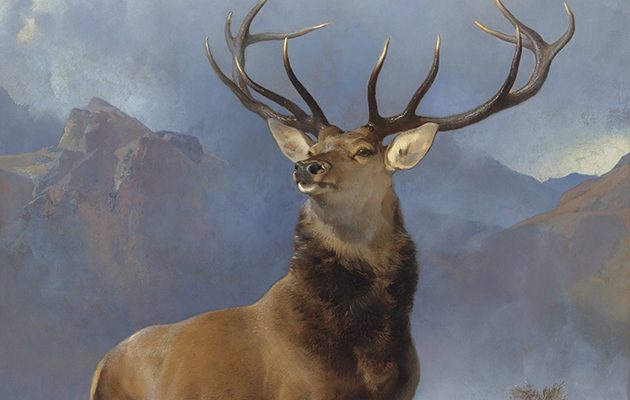Sir Edwin Landseer’s famous portrait of a stag has been secured for the nation but, finds Janet Menzies, this famous 12-pointer is still being shot at
The Monarch of the Glen has been secured for the nation and is setting off on a tour of Scotland. But the painting by Sir Edwin Landseer remains as controversial today as it was over 150 years ago, as Janet Menzies discovers.
For more sporting artists, Michael Parker owes his artistic technique to plastering. And John Skeaping’s work has become more widely accessible due to a chance encounter at Cheltenham.
SIR EDWIN LANDSEER
Sir Edwin Landseer’s triumph of Victorian romanticism, The Monarch of the Glen, has recently been bought from the Diageo drinks conglomerate for £4 million by the National Galleries of Scotland.
From October, the magnificent 12-pointer will be exhibited in Inverness, Perth, Paisley and Kirkcudbright. It is appropriate that the painting begins its tour of Scotland in the Highlands, at the peak of the red stag stalking season, because it seems that it is indeed up there to be shot at. Sir John Leighton, director general of the National Galleries of Scotland, explained why he felt he had to move quickly to buy the painting. “We wanted to work with Diageo because we couldn’t have competed had the painting come up for auction. To the people who are regularly in the Highlands for their sport, this is very much a ‘trophy painting’.”
Leighton won funding from the Heritage Lottery Fund, the Art Fund, the Scottish government and private trusts and individuals to save the work for a moderately grateful nation, moving The Guardian to question: “Is an elitist celebration of hunting in the Highlands, ignoring the displacement of working families in the 19th century, politically unpalatable?” The Scottish artist and critic Lachlan Goudie was slightly more balanced in his response, describing the painting as a “potent, visual evocation of Scotland’s impact upon the popular imagination – it’s right up there with bagpipes, tartan and a mouthful of shortbread”.
Yet the Scotland Goudie describes – the biscuit-tin world of Highland glens, swirling mists and equally swirling kilts – was invented by Landseer himself, in partnership with Sir Walter Scott and, most importantly, Queen Victoria and Prince Albert. When the royal couple created their Highland love nest at Balmoral, it fell to Scott and Landseer to chronicle their vision. Scott narrated it in his Waverley novels, while Landseer not only illustrated the Waverley series but painted the royal family living their Highland idyll.
Landseer’s brother, Thomas, was an engraver and his engravings of Landseer’s paintings became bestsellers. Most middle-class Victorian homes would have one and the waves of migrants to America took Landseers with them to remind them of an idealised version of home. Art historians like to dismiss Landseer’s work with a single word of scorn: “genre”. Certainly his moral and often sentimental paintings of animals do seek to tell a story – as genre work is prone to do. Yet, as Goudie points out, this doesn’t make him a lesser artist. “Landseer’s painting is also technically brilliant. Within the genre of animal painting he has never been surpassed. His ability to spirit up the physicality, the presence and even the character of any given animal marks him out as a virtuoso.”
More than 150 years later, we are all Landseer fans without even knowing it, so strongly has his imagery shaped our imagination. Think of a dog being noble and a heroic Newfoundland will come to mind, poised upon a crag, its thick black and white fur blown by the gale. Newfoundlands didn’t commonly have black and white fur until Landseer’s paintings – now there is a popular strain called the Landseer Newfoundland.
While Landseer was the darling of Victorian pop culture, he was as controversial in his day as he is now. When he completed The Monarch of the Glen in 1851 to hang in the House of Lords refreshment rooms, Parliament refused to pay for the commission. In 1861, his painting The Shrew Tamed was criticised. While the public saw a charming painting of a beautiful lady lying down alongside a fierce but gentled steed, The Times ranted: “For horses read husbands, and the picture is a provocation to rebellion addressed to the whole sex!”
Recognising that Landseer’s work can be interpreted on many levels, Leighton is pleased at the interest the tour is generating. “It had almost become an image you could no longer really see because it is so widely exploited. Don’t blame the painting for being such a powerful and popular work.”
Landseer’s sporting art is indeed gorgeous and satisfying to look at but what I love is that his stag, for all its traditional appearance, is today even more out there than Damien Hirst’s cows in Mother and Child (Divided).
The Monarch of the Glen is at Inverness Museum & Art Gallery, 6 October to 19 November, before moving to Perth, Paisley and Kirkcudbright.





